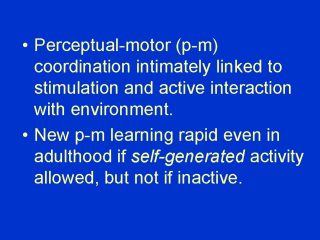| front |1 |2 |3 |4 |5 |6 |7 |8 |9 |10 |11 |12 |13 |14 |15 |16 |review |
 |
Like the yolked kitten, there is
growing evidence that, contrary to the strongly held “truth” that the CNS stops
growing around 12-16 years of age, it now seems that new neuronal and synaptic activity
continues throughout life. Adults can develop extensive new perceptual-motor skills,
provided that they indulge in self-generated activity. So, by practicing a sequence of
movements, new perceptual-motor skills, such as learning to ride a bicycle are possible.
But sitting on a motorized bicycle that actively turns the pedals while the rider
passively allows legs to be moved will not lead to new learning or neuronal development.
In other words, it is necessary for the person to struggle to establishing a form of
interaction with the stimulus configuration through initiated motor and probably cognitive
activity for new learning to occur. It is also possible to learn new ways of perceiving. Again, the flexibility of the CNS to recognize new stimulus configurations throughout life means that neuronal modification must also be occurring throughout life. Perception is an expanding horizon. When we are presented with new configurations or new meanings for old configurations, there is a period of adjustment, then the new doesn’t seem so new after a while. And one or two years later, it may appear quite ordinary. Art and music both attempt to present us with new perceptual challenges. Increasingly, technology expands the limited range of our senses to cover the entire electromagnetic spectrum, from radio waves to hard gamma rays. Yet we have no difficulty fitting in these new stimuli to our frames of reference. We gradually come to use them within our daily and ordinary lives, and often they become so automatic that we have no need to consciously attend to them, just like with constancies. |